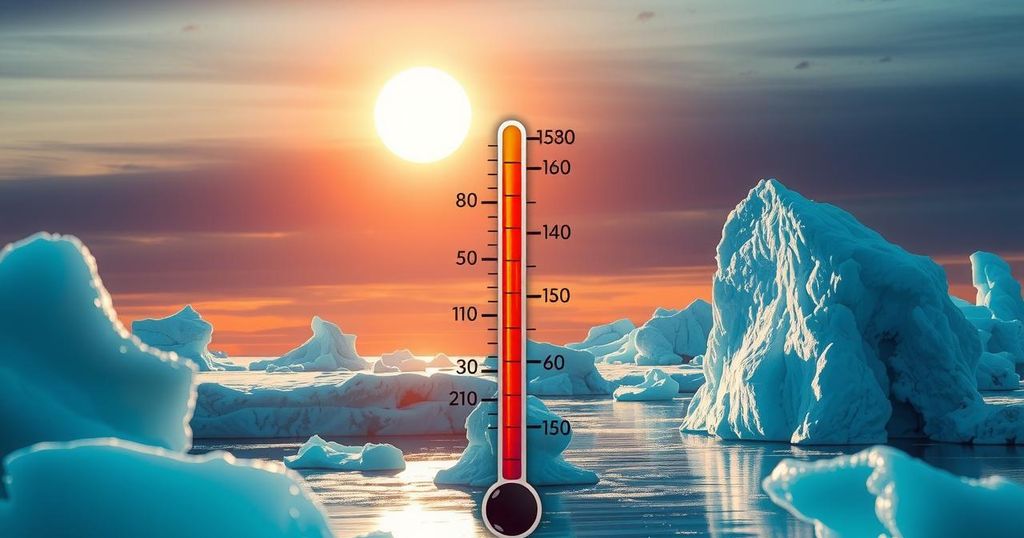January 2025 Records Unprecedented Warmth Despite La Niña Conditions

January 2025 likely became the warmest January recorded, with a 1.75°C anomaly above pre-industrial levels, outpacing previous records amidst La Niña conditions. Global temperature spikes were observed in both hemispheres. Climate experts Jorge Zeke Hausfather noted this unexpected warmth, suggesting that prolonged fossil fuel emissions significantly contribute to global climate change phenomena, overriding natural cycles.
January 2025 has potentially set a record as the warmest January, with a substantial temperature anomaly of 1.75°C above the pre-industrial average, according to analyses of the ERA5 dataset by climate experts. The rise in temperatures was noted globally, spanning both hemispheres amid the winter and summer seasons, indicating unusual climatic behavior despite prevailing La Niña conditions.
Recent reports revealed broken temperature records, notably in Jamaica and Madagascar, as documented by weather historian M Herrera. The ERA5 dataset is managed by the European Centre for Medium Range Weather Forecasting, which supports the Copernicus Climate Change Service under the European Commission.
The unexpected warmth in January transpired despite the ongoing La Niña phenomenon, typically associated with global temperature cooling. This trend marks a stark contrast to earlier years where warmer Januarys coincided with El Niño or neutral periods.
Prominent climate scientist Zeke Hausfather highlighted, “January 2025 was quite unexpectedly the warmest January on record at 1.75°C above preindustrial, beating the prior record set in 2024.” He reinforced that this occurred despite the existence of La Niña conditions, following the dissipating El Niño from the prior year.
The previous record warm January months occurred during El Niño events or during the lead-up to such conditions. The last El Niño phenomenon was officially recognized in mid-2023 and concluded in mid-2024, contributing to 2024’s ranking as the warmest year on record with a 1.55°C anomaly.
In December 2024, La Niña conditions were initiated and are predicted to persist through early 2025. The NOAA anticipates this La Niña will be brief, unlike the longer event from 2020 to 2023, which also saw significant heat waves despite its typically cooler effects.
Despite expectations for a cooler 2025, January’s temperatures suggest otherwise. Hausfather remarked, “Global temperature over the past few months have exceeded or been at the upper end of what we’ve seen after any other El Nino event in the historical record.”
Historically, Januarys during La Niña periods have tended to be cooler compared to surrounding El Niño or neutral years, except for January 2025. The unexpected record warmth may forecast higher annual temperatures than previously anticipated.
The rising temperature anomalies observed in January 2025 have drawn significant attention due to their unexpected nature during a La Niña phase, which typically results in cooler global temperatures. Anomalies are measured against a pre-industrial baseline, and recent reports indicate that the ongoing climate changes may be influenced more by anthropogenic factors than natural climatic patterns such as El Niño and La Niña. Notably, the history of temperature records is being reshaped by these events, highlighting the urgency of addressing climate change, as ongoing emissions from fossil fuels continue to impact global climate systems, even during traditionally cooler periods. Scientists are keenly observing these trends to understand the decisive factors contributing to such anomalies, especially as they may challenge existing climate models and expectations for future temperatures.
In conclusion, January 2025 has emerged as an exceptionally warm month, potentially the warmest on record, with a remarkable anomaly of 1.75°C. This occurred against the backdrop of La Niña conditions, defying previous expectations for cooler temperatures. Climate scientists emphasize the need to evaluate the reasons behind this anomaly, suggesting that anthropogenic climate change is significantly influencing global temperatures, leading to potential higher temperature expectations for the year ahead.
Original Source: www.downtoearth.org.in







